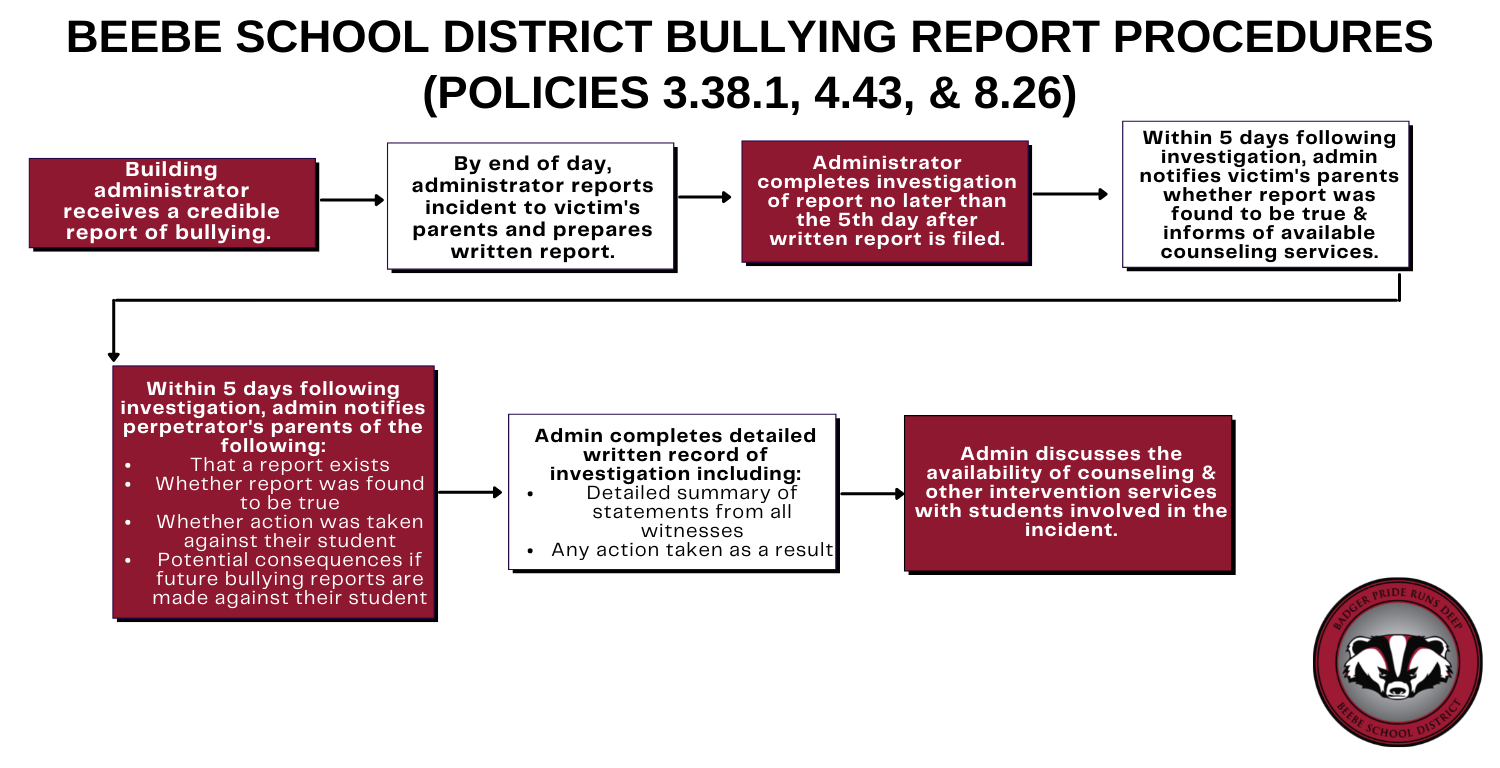Family & Student Resources
Curriculum & Instruction
Forms & Payments
Information
Our District
Calendars & Events
Staff Directories
Staff Resources
Beebe School District is committed to ensuring the safety of our students through consistent, zero tolerance anti-bullying procedures. School personnel work diligently to investigate each situation and respond accordingly.
As district policy states, “Respect for the dignity of others is a cornerstone of civil society. Bullying creates an atmosphere of fear and intimidation, robs a person of his/her dignity, detracts from the safe environment necessary to promote student learning, and will not be tolerated by the Board of Directors. Students who bully another person shall be held accountable for their actions.”
Students and parents or guardians are encouraged to report behavior they consider to be bullying to their teacher or to the building principal. Teachers and other school employees who have witnessed, or are reliably informed that, a student has been a victim of bullying are required to report the incident(s) to the building principal as soon as possible.
If you have been a witness to bullying or any other safety concern, please submit the following form and a school administrator will investigate the situation:
The following flowchart explains the process each time a credible report of bullying is made. Definitions are also provided to clarify what constitutes bullying, which may be seen in many different forms. More information may be found in District Policies 3.38.1, 4.43, and 8.26.

“Bullying” means the intentional harassment, intimidation, humiliation, ridicule, defamation, or threat or incitement of violence by a student against another student or public school employee by a written, verbal, electronic, or physical act that may address an attribute of the other student, public school employee, or person with whom the other student or public school employee is associated and that causes or creates actual or reasonably foreseeable:
Physical harm to a public school employee or student or damage to the public school
employee's or student's property;
Substantial interference with a student's education or with a public school employee's
role in education;
A hostile educational environment for one (1) or more students or public school
employees due to the severity, persistence, or pervasiveness of the act; or
Substantial disruption of the orderly operation of the school or educational environment
Examples of "Bullying" include, but are not limited to, a pattern of behavior involving one or more of the following:
Cyberbullying;
Sarcastic comments "compliments" about another student’s personal appearance or
actual or perceived attributes,
Pointed questions intended to embarrass or humiliate,
Mocking, taunting or belittling,
Non-verbal threats and/or intimidation such as “fronting” or “chesting” a person,
Demeaning humor relating to a student’s actual or perceived attributes,
Blackmail, extortion, demands for protection money or other involuntary donations or
loans,
Blocking access to school property or facilities,
Deliberate physical contact or injury to person or property,
Stealing or hiding books or belongings,
Threats of harm to student(s), possessions, or others,
Sexual harassment, as governed by policy 3.26, is also a form of bullying, and/or
Teasing or name-calling related to sexual characteristics or the belief or perception that
an individual is not conforming to expected gender roles or conduct or is homosexual, regardless of whether the student self-identifies as homosexual or transgender.
“Cyberbullying” means any form of communication by electronic act that is sent with the purpose to:
Harass, intimidate, humiliate, ridicule, defame, or threaten a student, school employee,
or person with whom the other student or school employee is associated; or
Incite violence towards a student, school employee, or person with whom the other
student or school employee is associated.
“Harassment” means a pattern of unwelcome verbal or physical conduct relating to another person's constitutionally or statutorily protected status that causes, or reasonably should be expected to cause, substantial interference with the other's performance in the school environment.
“Substantial disruption” means without limitation that any one or more of the following occur as a result of the bullying:
Necessary cessation of instruction or educational activities;
Inability of students or educational staff to focus on learning or function as an
educational unit because of a hostile environment;
Severe or repetitive disciplinary measures are needed in the classroom or during
educational activities; or
Exhibition of other behaviors by students or educational staff that substantially interfere
with the learning environment.